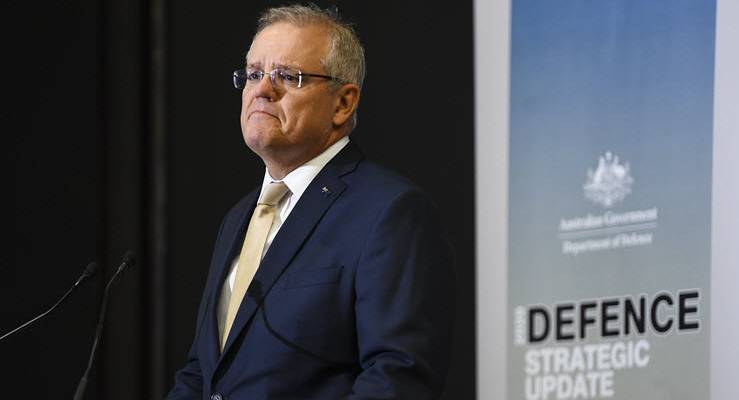
The long search for a stable object of nemesis has ended.
Thwarting China’s rise is now the organising principle of Australian defence and national security policy.
Defence Update 2020 (DU20), released on July 1, fits into the framework of the Pentagon’s Indo-Pacific Strategy Report of mid-2019. That document described China as a “revisionist power” which “undermines the international system from within,” “militarizes the South China Sea,” “employs non-military tools coercively”, and can conduct “increasingly complex operations in domains such as cyberspace, space, and electronic warfare operations.”
Defence Update 2020 doesn’t accuse China quite so enthusiastically; it mentions that country only nine times, referring to its “active pursuit of greater influence in the Indo-Pacific” and its “strategic competition” with the United States.
However, DU20 uses concepts that closely resemble the Pentagon’s, and — consistent with Australia’s sub-imperial posture — calls for military co-operation with the United States in the “north-eastern Indian Ocean, through maritime and mainland south-east Asia to Papua New Guinea and the south west Pacific.”
Clearly, the Indian Navy will be involved in more and bigger exercises with the Royal Australian Navy.
For its part, China will seek to highlight the February 2019 ruling by the International Court of Justice (ICJ) that Britain’s occupation of the Chagos Islands archipelago is wrongful. The US base on Diego Garcia is located there.
The UN General Assembly adopted a resolution in May 2019 reaffirming the ICJ’s conclusions and demanding that Britain withdraw unconditionally.
These issues are largely unknown to the Australian public, who therefore cannot critically evaluate claims about precisely who is undermining the rules-based international order.
DU20 envisages the ability to deploy forces to north Asia, described as “a region of global strategic and economic significance”. Pointing to the prospect of high-intensity conflict, it calls for “less risk-averse engagement with industry” to strengthen the supply of munitions and weapons systems.
That might mean a bonanza for high-end weapons suppliers.
DU20 is explicit in its call for “selectively increasing interdependence with the United States and other partners in more responsive and assured global supply chains.”
The announcement builds on earlier decisions to ban Chinese telco giant Huawei from supplying equipment to Australia’s 5G NR network.
The 20th century Cold War was between two opposing and mutually incompatible economic systems with military postures that provided continually escalating threats.
By contrast, given China’s ongoing economic importance to the global economy, Cold War 2.0 will be a technology cold war between two state-capitalist economies linked by global value chains and technological standards.
The new “digital iron curtain” that will separate the globe into US and Chinese technological zones runs through Australia.
For the last two decades, many Australian politicians have adopted a bumper sticker approach to military matters: “support the troops,” “lest we forget.”
There has been little substantial debate, let alone disagreement, about the nature, length, objectives and strategy of our presence in Afghanistan.
The last time Australia was involved in a high-intensity war was in Korea, almost 70 years ago. The last time Australians were killed by enemy air power was in Salamaua, in 1943.
This time things are likely to be very different.
An influential study in 2016 concluded that war between the US and China in the South China Sea “could be intense, last a year or more, have no winner, and inflict huge losses and costs on both sides.”
The consequences for Australia would be extremely serious: large casualty numbers; a steady parade of funerals; calls from the extreme political fringe for Chinese-Australians to be interned in camps; and massive economic disruption to several large economies in the western Pacific, since 95% of Chinese trade is seaborne.
The decision to commit Australian forces cannot be left to the prime minister alone. Parliamentary authorisation as to the scope and limits of Australian Defence Force involvement is now more urgent than ever.








Very solid, Clinton.
Kudos for the Chagos Islands mention, and its (manufactured) omission from the local ‘consciousness’.
I make no claim to a comprehensive understanding of the issues involved. But what worried me most was the second last sentence.
We desperately need another Whitlam to take a bit of a serious stand against the raw stupidity of the US military machine.
We would get a lot more respect from China if we showed some semblance of capacity for independent thought.
The Michael West investigation into the ASPI was an eye opener. A bad crew to be taking advice from.
Still trying to find a copy of your book Clinton…’What Uncle Sam wants …’..Hard to get a copy …Good article, btw…
Given Pine Gap, NW Cape, Darwin R&R transit camp and general undignified grovelling, the chances of this country having a sane China policy are a great deal less than zero.
As Great Gough found out, despite his bending the knee to the Hegemon over Timor.